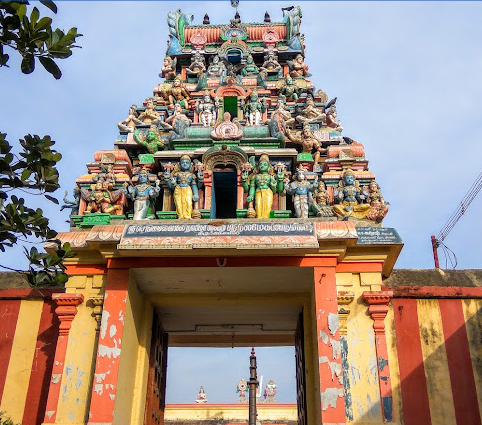Origin/History :-
The Sri Neelamega Perumal Temple, along with Thiru Manikundram and Thiru Thanjai Yali Temple, is situated in Thanjavur District, Tamil Nadu. These temples form a unique Divyadesam, where they are collectively worshipped as one sacred site. The temples are believed to have been established during the Chola dynasty, known for its extensive contributions to temple architecture and patronage of Vaishnavism.
Puranic Significance :-
Sthalapuranam 1 :
In the Krutha Yuga, three demons named Thanjagan, Thandagan, and Gajamugan undertook a rigorous penance to please Lord Shiva. Impressed by their devotion, Lord Shiva appeared before them and offered to grant them a boon. The demons, eager for power, requested the boon of immortality. However, Lord Shiva informed them that only Sreeman Narayanan, the preserver of the universe, had the authority to grant such a boon. He reassured the demons that they would not face death unless it was decreed by Sreeman Narayanan himself.
After receiving the great boon from Lord Shiva, the Asuras Thanjagan, Thandagan, and Gajamugan began to wreak havoc across the universe. They terrorised the Devas and Rishis, causing widespread chaos. During this time, a severe drought and famine struck the universe, sparing only one place: the abode of Sage Parasar, which remained abundant with food and water.
Learning of this, the Asuras descended upon Sage Parasar's dwelling and attacked him. In desperation, the sage called upon Lord Vishnu for help. Responding to the sage's plea, Lord Paranthaman unleashed his divine Chakra, destroying the demons who were causing so much suffering. However, the three Asuras Thanjagan, Thandagan, and Gajamugan were spared initially.
Lord Sreeman Narayanan then appeared before Thanjagan and beheaded him. In his final moments, Thanjagan realised the error of his ways and begged for Lord Vishnu's forgiveness. Moved by Thanjagan's repentance, Lord Vishnu pardoned his transgressions. The place where Thanjagan was slain became known as Thanjagan Oor, which later came to be known as Thanjavur, also called Tanjore.
Second demon, Gajamugan, transformed into an elephant and fiercely fought against Lord Vishnu. In response, Lord Vishnu took the form of Lord Narasimha, the half-man, half-lion avatar, and vanquished Gajamugan. Before his death, Gajamugan realised his mistakes and begged for forgiveness. The place where Gajamugan was slain became known as Thanjai Yali Koil, with "Yali" symbolising the elephant.
The third demon, Thandagan, terrified by the fate of his companions, fled to the Bhadala Logam (the netherworld) in an attempt to escape. However, Lord Vishnu assumed the form of Varaha, the boar avatar, and plunged into the Bhadala Logam to destroy Thandagan. The place where Thandagan was killed became known as Dandakaranyam. After beheading Thandagan, Lord Vishnu appeared as Bhuvaraha Murti, and this form is worshipped in Srimushnam. In the end, Lord Vishnu granted salvation to all three demons, offering them redemption for their actions.
Sthalapuranam 2 :
According to legend, Shakuntala was married to King Dushyanta, but upon returning to his kingdom, the king forgot about his wife due to a curse. During this time, Shakuntala gave birth to their son, Bharat. However, she lost the ring that King Dushyanta had given her, which had fallen into a river and was swallowed by a fish. A fisherman later caught the fish, found the ring, and returned it to the king. Upon seeing the ring, King Dushyanta's memories of Shakuntala returned, and he immediately rushed to the forest to reunite with her and their son.
The role of the fisherman in reuniting Shakuntala and King Dushyanta is why fishermen are sometimes referred to as "Bharathyar." In honour of this connection, it is believed that Lord Vishnu married Princess Padmavathi, who was from a fishing community. To commemorate their divine wedding, fishermen celebrate Pongal each year and offer prayers to the Lord, continuing the tradition of gratitude and devotion.
